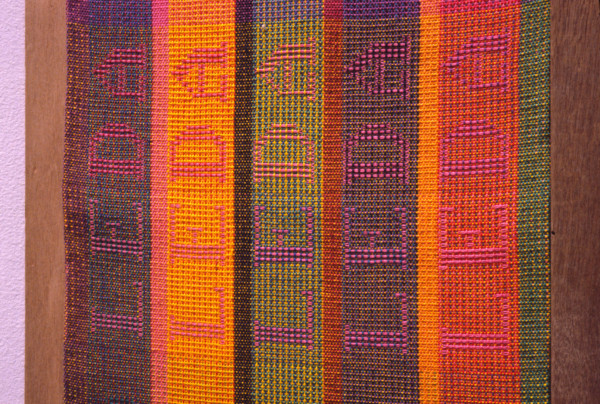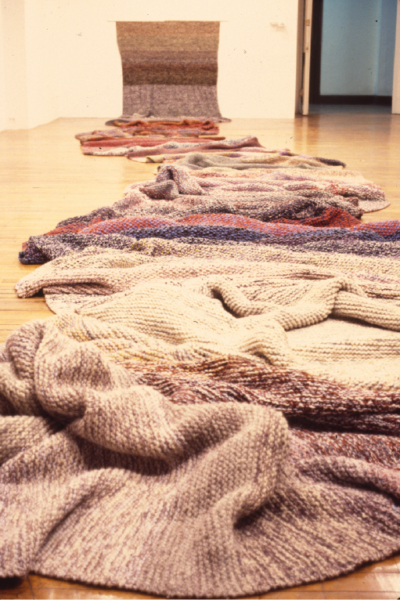- Gillian Collyer, Catherine Heard, Germaine Koh, Roxane Permar & Wilma Johnson, Ruth Scheuing
- Gillian Collyer, Catherine Heard, Germaine Koh, Roxane Permar & Wilma Johnson, Ruth Scheuing
- Gillian Collyer, Catherine Heard, Germaine Koh, Roxane Permar & Wilma Johnson, Ruth Scheuing
- Gillian Collyer, Catherine Heard, Germaine Koh, Roxane Permar & Wilma Johnson, Ruth Scheuing
Gillian Collyer, Catherine Heard, Germaine Koh, Roxane Permar & Wilma Johnson, Ruth Scheuing
22 April–
20 May 1995
Curated by: Janis Bowley


Ruth Scheuing, Arachne’s Tapestry, 1992. Courtesy of the Artist.


Roxane Permar & Wilma Johnson, The Craft Cosy Project, 1992. Courtesy of the Artist.


Roxane Permar & Wilma Johnson, The Craft Cosy Project, 1992. Courtesy of the Artist.


Germaine Koh, Knitwork, 1992. Courtesy of the Artist.


Cathrine Heard, After Vidius (c.1611), After Bartisch (c.1575), After Vesalius (c.1543), 1992. Courtesy of the Artist.
Gillian Collyer, Catherine Heard, Germaine Koh, Roxane Permar & Wilma Johnson, Ruth Scheuing
Curated by: Janis Bowley
The OR Gallery is proud to present a group exhibition of contemporary artists who incorporate traditional needle arts techniques into their work. These constructions embody the artists’ individual explorations of community, social structure and feminist themes.
Gillian Collyer
Halifax, Nova Scotia
Smocked Shirts
Gillian Collyer uses ‘smocking stitch’ in an unconventional manner to transform a series of white men’s shirts. The shirts are on hangers suspended in a series within the gallery. Through this concentrated process of stitching, the artist meditates on her experiences within the corporate world.
I’ve spent a good deal of time in what I’ll call the ‘corporate culture’- the business world. This has always been an alienating experience for me and one that I’ve thought a lot about, since like a lot of people, I have to find ways to make a living that aren’t aways where I’d like to be.
These shirts were my way of dealing with that dilemma over this past summer. I spent my days in front of a computer terminal in a government ministry and in the evenings I worked on the shirts. The gesture was about symbolically inserting myself into a place where I felt invisible.
This particular type of needlework – smocking- appealed to me for a number of reason. The process is quiet and meditative, requiring patience and concentration. The absurdity of applying a decorative element from girls’ dresses to men’s business shirts was appropriate and the idea of using this underdog craft had a subversive appeal for me. Historically it’s been the needle, not the paintbrush, that has been taken up by women. As I see it, the art world could benefit from a shot in the arm.
Having said that, I would have to add that I don’t see this work as relevant only to women since the problem of finding a place and voice in our society extends across class, race and gender lines. I hope that the shirts have something meaningful to say to a wide range of people.
Cathrine Heard
Toronto, Ontario
After Vidius (c.1611), After Bartisch (c.1575), After Vesalius (c.1543)
Catherine Heard’s installation consists of three stands of the type used for needlework. The cotton panels are embroidered with human hair and depict early anatomical illustrations. Heard explores the persistent concepts associated with female sexuality and psychology.
In my most recent bodies of work I have used the traditional women’s media of embroidery and sewing to explore the persistence of ideals and myths about female sexuality and psychology from the Victorian and pre-Victorian eras into the twentieth century.
In making and exhibiting these works I have become interested in what I have come to call the “disagreeable object” – an object which at once fascinates and repulses, evoking a conflict of emotions. In these works disagreeable objects have been embodied as freaks of nature including Siamese Twins. The female body and mind also may be categorized as “disagreeable” as they have historically been perceived by doctors and anatomists as an aberrant, inferior or imperfect versions of the male ideal. The embroideries presented at the OR Gallery are based on drawings by prominent 16th and 17th century anatomists who model the female reproductive system upon the male.
Certain materials lend themselves to the creation of the “disagreeable object”. In these embroideries, huma hair serves as a substitute for silk. The disembodied hair symbolically links the themes of death and sexuality and evokes an uncomfortable visceral presence. I also reference the Victorian tradition of making mourning jewelry or commemorative pictures from the hair of the deceased. The obsessive nature of embroidery is also key to the neurotic nature of the “disagreeable object”.
Germaine Koh
Ottawa, Ontario
Knitwork
In 1992 Germaine Koh began unravelling used sweaters and re-knitting the wool, on a 2m width, into a continuous length (approx 1m. per month). Accompanying the knitwork is photographic documentation of the, now extinct, garments. This long-term venture is in keeping with Koh’s method of working which includes other found, collected and reconfigured objects (i.e. lumber and snapshots).
Begun on the 21st of February 1992, Knitwork is generated by my unraveling used garments (donated, found, or gleaned from thrift shops) and re-knitting their entrails into one, ever-increasingly, long blanket. This ongoing record of the passage of time, effort and particular details acts as its own archive of and monument to the abstracted artifacts that comprise its. Its massiveness is a weighty, recalcitrant, public manifestation of mundane activity and a measure of commitment. Although its accretion of strata comprised of disused good might seem akin to geologic time, its growth is not inexorable; the work will be finished when I cease. At once excessive and banal, rigorous and formless, sublime and absurd, this work is a practical test of the imagination.
Roxane Permar & Wilma Johnson
London, England & Papil, Burra, Shetland
(In collaboration with traditional knitters of the Shetland Islands)
The artists initiated The Craft Cosy Project in 1992 which involves community members in the construction of a hand-knitted covering for installation over a croft or stone cottage. Knitters with contribute pieces constructed in traditional ‘Shetland Island’ style which will then be sewn together and attached to a frame surrounding the croft. In this exhibition, the artists will be showing photo documentation of models in the landscape.
The Craft Cosy Project
The artists initiated this ongoing collaborative project in 1992. It aims to involve community members in the construction of a hand-knitted covering for installation over a traditional croft house. Knitters will contribute pieces of traditional Shetland and Fair Isle patterns which will then be sewn together and attached to a frame temporarily surrounding the croft. The OR exhibition consists of colour photo documentation of models in the landscape.
The Croft Cosy brings ideas and concerning nature, the land and the landscape together with those of gender and identity. It places women’s work firmly in the landscape as part of the working life related to the land and sea. It helps to highlight the fact that our landscape is not aural but part of working history. As knitting isa labour-intensive, repetitive activity, so is the working of the and sea. Wile knitting is now largely perceived as a indoor, domestic, leisure activity, in the past women in Shetland knitted while working and walking outdoors. Knitting formed an integral part of crafting life, providing the only steady or stable form of its livelihood.
This project crosses cultural disciplines, bringing traditional craft practices into the sphere of fine art, performance, architecture and engineering. The Croft Cosy Project raises questions across a range of theoretical issues including notion of tradition and history in relation to contemporary culture and society; gender concerns in relation to economic, social and cultural circumstances; and questions of identity in relations to urban and rural centres, peripheral and central locations.
Ruth Scheuing
Vancouver, British Columbia
Ruth Scheuing explores textiles as language and language used in textiles. Using computer loom technology Scheuing has developed a system for weaving letters and text and this installation uses stories and names of women from the Greek myths associated with weaving. There is also an audio component to the installation.
Arachne’s Tapestry
Arachne of Macedonia, wove, at first, the story of Europa as the bull deceived her, and so perfect was her art, it seemed a real bull in real waves…Ovid ‘Metamorphoses’ book VI
Arachne challenged the goddess Athena to a weaving competition and they each completed a tapestry with specific narratives. Athena, as a warning, depicted the power of Gods and Goddesses over humans and showed how humans were punished for forgetting this. Arachne depicted 21 instances of ‘deceptive seductions’ or rapes, deeds done by the Olympian gods to mortal and immortal women.
“And she wove Asterie seized by the assaulting eagle; and beneath the swan’s white wings showed Leda lying by the stream:”
When Athena saw this, she was so angry that the she tore the tapestry apart. Arachne, in her sorrow, tried to hang herself and Athena, no regretting her rash act changed her into a spider, an older and self-governing weaver, but silencing the woman Arachne, making her a lasting symbol for the defiant woman, who dared to challenge laws of the Gods.
This early Greek period interests me for the ways it reflects changing attitudes towards women through stories about their work as weavers, from primordial Goddesses, who as spinners create life, to the Fates, feared for their powers to spin, measure ad cut the ‘thread of life’, to Penelope, who has to lie about her task. Ovid’s Metamorphoses is my source for these stories and I like his descriptions as acts of deception and cheating.
Arachne’s Tapestry is a reweaving of the original work. It is part of a continuous series of works which started with Penelope.
I would like to thank the Banff Centre for access to the computer room and use of the Sound Studio; and am grateful to the Canada Council for financial support.
Special thanks go to Mark Patch, for producing the soundtrack and to Janis Bowley and Sandy Vida for lending their voices for the soundtrack.












